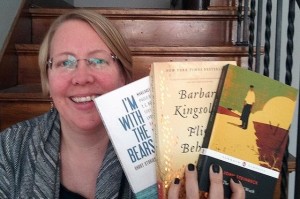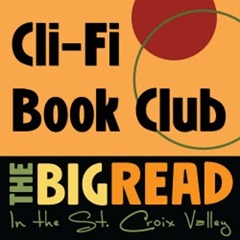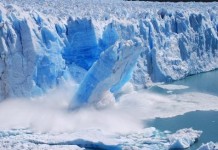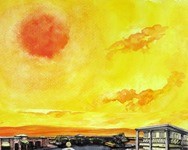
Thanks to “Earth Journal” columnist Ron Meador and MinnPost for permission to reproduce his commentary below.
What appears to be the nation’s first community book clubs devoted to reading “Cli-Fi” — fiction focused on climate change and its impacts — had a first gathering on Tuesday evening in an old Victorian house in Stillwater.
The starting texts are the anthology “I’m With The Bears: Short Stories From a Damaged Planet” and Barbara Kingsolver’s novel “Flight Behavior”; members will choose others later on. The sponsoring organization is ArtReach St. Croix.
And the basis for conferring first-in-the-nation status comes from none other than Dan Bloom, a Taiwan-based blogger who evidently coined the term “Cli-Fi” and curates a steady stream of reports for academics and others interested in what he considers a distinct and important literary genre.
Of course, nobody knows how many informal home- or office-based reading groups might also have Cli-Fi as a focus. But because the three ArtReach clubs in Stillwater, Prescott and St. Croix Falls are part of an effort backed by public libraries and the National Endowment for the Arts – which likely will involve thousands of people in the St. Croix River Valley over the next few months – Bloom found it worth this note in his blog on Tuesday:
Although this reporter has been following the rise of the CF genre over the past few years, I had no idea that these specialized book clubs were coming. In fact, I had never met Ms. Rutledge before last week. This idea is her idea, and she carried it out with her team in Minnesota.
That would be Heather Rutledge, ArtReach’s executive director, who for the second year is lending her organization’s considerable resources to an annual NEA project called the Big Read.
Basic idea here is to get a lot of people to read an important American classic together, and then to extend their connection to its subject with supplementary materials and activities.
Such programming is a core enterprise for ArtReach, a nonprofit devoted to building ever broader connections between communities and their resident artists in a wide range of disciplines. (Also for Arts Midwest, the Minneapolis-based outfit that manages the Big Read programs nationwide for the NEA.)
“Part of grantwriting is imagining what’s possible,” Rutledge told me on Tuesday, “and all different ways to connect people to the common book title, which for 2016 in the St. Croix Valley is ‘The Grapes of Wrath.’
“So we are planning theater, visual arts programming, music and, of course, book discussions. In investigating and imagining what was possible, a friend of mine pointed out to me this new subgenre of contemporary fiction called Cli-Fi.
“We were talking about ‘The Grapes of Wrath’ and how it brings up really relevant and timely themes, including climate change – all of the characters in the book responding to this new reality of the Dust Bowl. And then we began to talk about other Cli-Fi books that people could read as well.”
Landscape as character
To the red country and part of the gray country of Oklahoma, the last rains came gently, and they did not cut the scarred earth. The plows crossed and recrossed the rivulet marks. The last rains lifted the corn quickly and scattered weed colonies and grass along the sides of the roads so that the gray country and the dark red country began to disappear under a green cover. In the last part of May the sky grew pale and the clouds that had hung in high puffs for so long in the spring were dissipated. The sun flared down on the growing corn day after day until a line of brown spread along the edge of each green bayonet. The clouds appeared, and went away, and in a while they did not try any more. The weeds grew darker green to protect themselves, and they did not spread any more. The surface of the earth crusted, a thin hard crust, and as the sky became pale, so the earth became pale, pink in the red country and white in the gray country.
In the water-cut gullies the earth dusted down in dry little streams. Gophers and ant lions started small avalanches. And as the sharp sun struck day after day, the leaves of the young corn became less stiff and erect; they bent in a curve at first, and then, as the central ribs of strength grew weak, each leaf tilted downward. Then it was June, and the sun shone more fiercely. The brown lines on the corn leaves widened and moved in on the central ribs. The weeds frayed and edged back toward their roots. The air was thin and the sky more pale; and every day the earth paled.
So begins “The Grapes of Wrath,” a somewhat unlikely monument in American literature.
Devoted to the struggles of poor people, suffused with class politics, scorned by large portions of the American literary establishment, it remains at 76 years of age among the novels most frequently assigned by high-school teachers. Also, among those most frequently banned by school boards; at the moment it holds the No. 3 spot on the American Library Association’s list of “Banned & Challenged Classics.”)
It is an entirely radical book, a ceaseless indictment of the monetary-industrial complex of banks and corporations that responded to the suffering of Dust Bowl farm families with eviction, sending them away to suffer and starve somewhere else.
So radical, in fact, that a significant portion of the American literary establishment raised a protest when the book was published in 1939 and again when the Nobel Prize was awarded to Steinbeck in 1962, with “Grapes” highlighted in the citation. The tastemakers were still annoyed that a work so plainly polemical was being taken for art.
But Steinbeck’s is also a book in which landscape is a principal character, remarkably so. And though it is fiction, its treatment of land and drought, of swirling dust and withering crops, carries an unmistakable, factual credibility because it is grounded in observations he gathered as a freelance newspaperman and then as a documentary screenwriter reporting on the displaced farmers of Oklahoma.
Climate as context
I can hear the quibbling already – rejoinders that the Dust Bowl conditions were created by poor land management practices in addition to severe drought, that difficult periods of drought have long been a fact of life in the American Southwest and would be so today even if the climate weren’t shifting to hotter, drier conditions in general.
These points have some merit, of course, and Rutledge told me the Big Read programming promises some interesting local context on those topics.
I’ve come to learn that the Washington County conservation district, and all the districts in this area, were a direct response to the Dust Bowl. It became a matter of national security to look to soil and water conservation.
The Washington County district’s Minnesota State Fair booth in 1939 and 1940 was filled with posters about [World War II] and what you could do on the home front, and it was about plowing fields along with the topography and planting buffer zones to reduce erosion.
So we have some good historical photos from the Library of Congress and the Office of War Information that we’re asking artists to respond to, and that’s what we’ll be building our visual arts exhibition around.
The artist’s role
Cli-Fi may have a couple of vulnerabilities with portions of the fiction-reading public. Though it need not be speculative fiction or science fiction, as Rutledge points out, it is very often one or the other or both, and not everybody likes those approaches.
At her suggestion I read Nathaniel Rich’s story “Hermie,” which features a talking hermit crab and his thoughts about the destruction of coastal environments, and the best I might say of it was that it certainly was imaginative.
 But I look forward to learning, after I’ve finished this scribbling, what Margaret Atwood, T.C. Boyle and others have to say on the subject. And it will be interesting to see how the Big Readers react as well.
But I look forward to learning, after I’ve finished this scribbling, what Margaret Atwood, T.C. Boyle and others have to say on the subject. And it will be interesting to see how the Big Readers react as well.
However, I happen to think that adding the Cli-Fi dimension was Rutledge’s second-best idea for this year’s program. Number One was the brilliant notion of seeing, and framing, “The Grapes of Wrath” as a book about climate disruption and its consequences.
In the introduction he provided for “I’m With the Bears,” Bill McKibben notes that, “The problem with writing about global warming may be that the truth is larger than usually makes for good fiction.” This complicates the artist’s responsibility “to help us understand what things feel like.”
On a stable planet, nature provided a background against which the human drama took place; on the unstable planet we’re creating, the background becomes the highest drama. So many of these pieces conjure up that world, and a tough world it is, not the familiar one we’ve loved without even thinking of it. Those are jolts we dearly need; this is serious business we’re involved in.
But of course the terrestrial climate has not always been so stable that we could love it without thought, and the nonspeculative literature of past catastrophe can certainly help us to feel what it might be like to confront future disasters.
Given its track record, “The Grapes of Wrath” – framed and read in the way Rutledge proposes – might just be the most potent text available for the purpose.
TELEREAD PUBLISHER’S NOTE (Not in the MinnPost article): Heather Rutledge, the organizer of the cli-fi book clubs in Minnesota, told Dan Bloom in an email after the first event:
“Our first Cli-Fi book club was a great and lively discussion with a nice group of people around the galleries at ArtReach. There were other people who read the book and planned to attend, but couldn’t for various reasons.
”I do think continuing this for at least a year will be possible with some modest funding. It was very good to have our little lending library especially since I’m With the Bears was a little difficult for our local bookstores to get a hold of and it is not a title that is in our libraries.
”We have limited technical abilities to include Skypers or others, but I’m curious to investigate what this could take. My first focus was to get readers from the St. Croix Valley engaged in the conversation. I think last night’s discussion was incredible. So many good stories to start our conversations about climate change.”
Previous TeleRead coverage of the Minnesota clubs appeared here.
– David Rothman

































